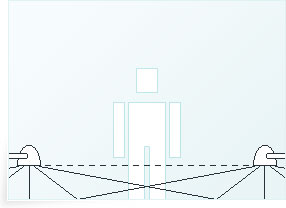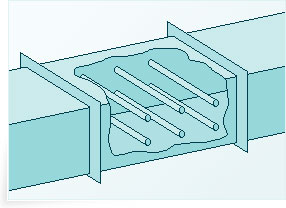Application
Good results are obtained with this form of disinfection because air has a low absorption coefficient and hence allows UVC to attack microorganisms efficiently.
Presently, there are five basic methods of air disinfection using ultraviolet lamps namely:
1. Ceiling or wall mounted UV lamps

This method is used in those cases where either the interior is unoccupied or where it is possible for the occupants to take protective measures against radiation.
2. UV lamps in upwards-facing reflectors for upper-air irradiation

This method of disinfection can be used to combat bacteria and moulds. It also has the advantage that it can be used in occupied interiors without the need of protective clothing.
3. UV lamps, incorporated in stand-alone air cleaners with a simple filter
In essence the units consist of UV lamps, mostly types driven by high frequency ballasts, mounted inside a »light trap« container.
4. UV lamps in downwards-facing reflectors for irradiation of the floor zone (often in combination with 2.)

This method is for use in those cases where it is important that the entire room air, even at floor level is rendered as sanitary as possible. In this case, lamps supplementing those irradiating the upper air should be fitted in downward-aimed reflectors at about 60 cm above the floor.
5. UV lamps in air ducts sometimes in combination with special dust filters

The injected air can be disinfected to a ex ante specified level, depending upon the number of lamps installed and the dwell time, that is the time spent in the effective killing region of the lamp(s). By definition this takes the dimension of the air duct into consideration. Such systems have a controlled flow rate and their performance can be predicted theoretically.
Fields of application
Air disinfection
Traditional methods of disinfection of objects for example in medical laboratories fail to disinfect the air because microorganism floats completely free. Application of UV in air ducts for ventilation, heating and cooling purposes has proven to provide adequate protection against airborne pathogens. With patients and visitors bringing in pathogens that cause diseases such as tuberculosis, wards, clinics, waiting and operation rooms and similar areas should be protected against the risk of infection of personnel and patient populations. It is estimated that up to 99% of airborne pathogens are destroyed with adequate air circulation and UV exposure.
Cooling coils
Air conditioner cooling coils are almost always wet and dusty and thus can serve as an ideal breeding ground for moulds, a known allergen. Coil irradiation with UV drastically reduces or prohibits growth of moulds. At the same time heat exchange efficiency is improved and pressure drops decrease. As the coils are constantly irradiated, only a modest UV irradiance is required.
Air-conditioning systems
UV-radiation sources can be installed on the ceiling but also in the channel of an air conditioning system. Hence this is an excellent possibility to deliver hospitals and offices disinfected fresh air. It is also possible to install UV-radiation systems with high level of performance in air channels of cooling systems (for example in the production of bred) with antiseptic effect.
Bakers's shop
The main source of danger in the production of bred or related products is the presence of mould spores in the beginning of production. Direct disinfection of production facilities in connection with air disinfection lowers the rate of germs considerable. Radiation of packaging materials reduces perishableness of foodstuff.
- Pastry production
- Bred and cold rooms
- Bred cutting plants
- Packaging machines and areas
Butcher's shop
It is very difficult to keep meat free from bacteria's and germs in all steps of the supply chain. This follows from the high concentration of proteins which ensures ideal conditions for the development of cultures of microorganism. Air disinfection in connection with disinfection of object surfaces has to be applied. Radiation of packaging materials reduces perishableness of foodstuff.
Meat-storage room
- Meat counter
- Sausages machines
- Production facilities for tinned food
Dairies
UV sources are used to protect the original cultures from infection through »wild« organism in the air. Hence indirect air-disinfection has to be applied primarily. Container should be freed from germs before filling with products or intermediate products. Radiation of packaging materials reduces perishableness of foodstuff.
- Filling of milk
- Production and storage area of cheese
- Disinfection of tanks
Breweries
In this context we have to focus not on pathogen germs but on the removing of moulds and yeast. Because of the lower sensibility of these pests, especially in the stadium of spore, a higher UV radiation performance has to be used.
- Disinfection of tanks
- Bottling plants
- Fruit storage and packaging areas
- Production areas of canned fruits or vegetables
Medicine and und Pharmacy
UV based disinfection is a very efficient method in situations where pathogen germs can affect people (or materials) via contaminated air. The risk of infection via air which is the major source for many diseases can be reduced significantly. A 100% elimination of germs is neither possible nor necessary. Various studies confirmed that it is sufficient achieve a material reduction of the level of germs. Infectious diseases often are the result of mixed infections via contaminated surfaces and air. Therefore UV based disinfection is recommended within clinics, waiting and operation rooms and similar areas with personnel and patient populations.
- Indirect or direct exposure
- Disinfection of work stations
- UV radiation barrier between rooms
- Air conditioning
- Instrument boxes
Animal Breeding
Indirect disinfection o fair can lead to a significant reduction of characteristic animal diseases.
- Animal breeding – especially young pigs and poults
UV-radiation barrier
To prevent the inflow of contaminated air from one room into another it is possible to install UV-radiation barriers. Although UV-radiation barriers imply a direct radiation persons can be present for a short time within the radiation area. (it is recommended to direct the radiation via lamella)
- Air disinfection PURION.pdf(99 Kb)
